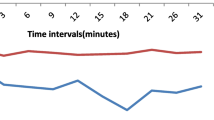Abstract
Purpose
Raised serum uric acid, a marker of oxidative stress, is known to increase vascular tone and depress myometrial contractility. A rise in serum uric acid levels has also been reported during labor, warranting its correlation with post-spinal hypotension and uterine tone.
Methods
Serum UA sample was drawn from enrolled healthy, laboring parturients. Of these, 100 women who required emergency cesarean delivery were re-sampled prior to surgery. Following spinal anesthesia we recorded episodes of hypotension (MAP < 80% of baseline), use of vasopressors and supplemental uterotonics. The primary outcome was maternal hyperuricemia (1SD > appropriate for gestation age) and its correlation with post-spinal hypotension. Secondary outcomes were total vasopressors used, duration of labor and its effect on uric acid levels, uterine tone and neonatal outcome.
Results
Hyperuricemia was observed in 33% of parturients. On comparing with women showing normal uric acid levels, hyperuricemic parturients experienced significantly lower incidence of post-spinal hypotension (45.5% vs. 67.2%; p value = 0.04) and lower vasopressor usage (p value = 0.06). Clinically, an increased use of supplemental uterotonics in these parturients was noted (p = 0.20). The duration of labor had no impact on uric acid levels. Neonatal outcome was unaffected.
Conclusions
In healthy, normotensive parturients undergoing emergency cesarean delivery, maternal hyperuricemia is associated with lower incidence of post-spinal hypotension and reduced need of vasopressors. Elevated serum uric acid levels may also be associated with decreased uterine tone, necessitating greater requirement of supplemental uterotonics. However, further prospective trials are needed to strongly establish this association.





Similar content being viewed by others
References
Bishop DG (2014) Predicting spinal hypotension during caesarean section. South Afr J Anaesth Analg 20(4):170–173
Montoya BH, Oliveros CI, Moreno DA (2009) Managing hypotension induced by spinal anesthesia for caesarean section. Rev Col Anest Mayo Julio 37(2):131–140
Lapins E (2001) Hypotension during spinal anaesthesia for caesarean section. Int J Obstet Anesth 10:226
Sharma RK, Agarwal A (2004) Role of reactive oxygen species in gynecologic diseases. Reprod Med Biol 3:177–199
Lam C, Lim KH, Kang DH, Karumanchi SA (2005) Uric acid and preeclampsia. Semin Nephrol 25:56–60
Kovacheva VP, Soens MA, Tsen LC (2013) Serum uric acid as a novel marker for uterine atony and post-spinal vasopressor use during cesarean delivery. Int J Obstet Anesth 22:200–208
Lind T, Godfrey KA, Otun H, Philips PR (1984) Changes in serum uric acid concentrations during normal pregnancy. Br J Obstet Gynaecol 91:128–132
Amini E, Sheikh M, Hantoushzadeh S, Shariat M, Abdollahi A, Kashanian M (2014) Maternal hyperuricemia in normotensive singleton pregnancy, a prenatal finding with continuous perinatal and postnatal effects, a prospective cohort study. BMC Pregnancy Childbirth 18:104
Mohta M, Janani SS, Sethi AK, Agarwal D, Tyagi A (2010) Comparison of phenylephrine hydrochloride and mephenteramine sulphate for prevention of post-spinal hypotension. Anaesthesia 65:1200–1205
Spahn DR (2000) Perioperative transfusion triggers for red blood cells. Vox Sang 78(2):163–166
Crawford MD (1939) The effect of labour on plasma uric acid and urea. BJOG 46:540–553
Rout CC, Rocke DA (1994) Prevention of hypotension following spinal anesthesia for cesarean section. Int Anesthesiol Clin 32:117–135
Bainbridge SA, Roberts JM, Versen-Höynck FV, Koch J, Edmunds L, Hubel CA (2009) Uric acid attenuates trophoblast invasion and integration into endothelial cell monolayers. Am J Physiol Cell Physiol 297:C440–C450
Zharikov S, Krotova K, Hu H, Baylis C, Johnson RJ, Block ER et al (2008) Uric acid decreases NO production and increases arginase activity in cultured pulmonary artery endothelial cells. Am J Physiol Cell Physiol 295:C1183–C1190
Mustaphi R, Gopalan S, Dhaliwal L, Sarkar AK (1996) Hyperuricemia and pregnancy induced hypertension-reappraisal. Indian J Med Sci 50:68–71
Funding
None.
Author information
Authors and Affiliations
Contributions
NB: protocol development, data collection, data analysis, manuscript writing. RS: protocol development, patient recruitment, data collection and data analysis, manuscript writing. KJ: protocol development, data analysis and manuscript writing. PS: protocol development, data analysis, manuscript editing. IV: protocol development and data analysis, manuscript editing.
Corresponding author
Ethics declarations
Conflict of interest
The authors declare that they have no conflict of interest.
Ethical approval
All procedures were in accordance with the ethical standards of the institutional research committee and with the 1964 Helsinki declaration and its later amendments or comparable ethical standards.
Informed consent
Informed consent was obtained from all individual participants included in the study.
Additional information
Publisher's Note
Springer Nature remains neutral with regard to jurisdictional claims in published maps and institutional affiliations.
Rights and permissions
About this article
Cite this article
Bhatia, N., Shanmugam, R., Jain, K. et al. Maternal hyperuricemia as a marker of post-spinal hypotension and uterine tone during cesarean delivery: a prospective observational study. Arch Gynecol Obstet 300, 925–931 (2019). https://doi.org/10.1007/s00404-019-05282-x
Received:
Accepted:
Published:
Issue Date:
DOI: https://doi.org/10.1007/s00404-019-05282-x




